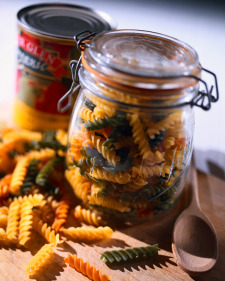6 Keys to Mastering the Evening Meal (Part 2)
 Monday, March 7, 2011 at 11:47AM
Monday, March 7, 2011 at 11:47AM Part Two: Keys 3 - 6

Yesterday we talked about planning ahead, and creating a cook-friendly kitchen, all in the effort to make getting a healthy and nutritious meal on the table easier than you believed is possible. Today we cover four more keys to that end.
3. Keep staples stocked. There are certain items that store well and that can be used in a number of dishes or that can make meals themselves (pasta, spaghetti sauce, rice, etc.). Having these items on hand can help ease nightly preparation, as well as serve as quick-fixes when in a pinch. Here’s a minimal basic list of staples to start with, which you can add items to as you determine what best suits your needs.
Trips to the grocery store may also be minimized by keeping a running list of items nearing depletion. Keep this list (along with a pen) in a convenient location and train your family to update it.
4. Prep ahead. Having your vegetables already washed and ready for use is a blessing after a long day. Get in the routine of washing produce after shopping—before it gets put away. Enlist a helper, one of you can wash and cut, while the other unloads and puts away the remaining groceries.
Washed produce may be stored in plastic bags with holes poked in them or in perforated bags made for produce.
5. Use time-saving/convenience products. You have the option to buy lettuce in a bag that’s already washed and torn, precut fresh stir-fry vegetables, and cleaned and/or cut melons, berries and pineapple.
Frozen vegetables are comparable to fresh nutritionally and can help to save both preparation and cooking time in the kitchen. They are also a great way to keep vegetables on hand since they take up little room in the freezer and can be stored for extended periods of time. Plus frozen vegetables also reduce waste from fresh veggies that don't get used, which in the end saves you money.
Having canned fruits, vegetables, and beans on hand is another time-saver. Look for fruits packed in their own juice or water instead of syrup. Use low-sodium vegetables if you need to limit your sodium intake. Items such as minced garlic, soup stock, precut meat, or poultry, and chopped nuts are other time-savers.
6. Batch-cook and freeze. If you’re going to be in the kitchen anyway, why not double the recipe? The “planned-overs” will make great lunches, can be incorporated in another meal later in the week, or can be frozen for a no-fuss meal next week.
You can do it! Mastering the evening meal boils down to planning ahead, keeping staples stocked, and working smart instead of hard—by creating a cook-friendly kitchen. It’s really not so difficult; it does require your decision to problem-solve and a little practice!
Best,
-Dorene
What tricks do you use to get yourself and/or your family fed in a nutritious way each evening? Please comment here; you can also email me with any questions at dorene@beyonddiets.com.

Reader Comments